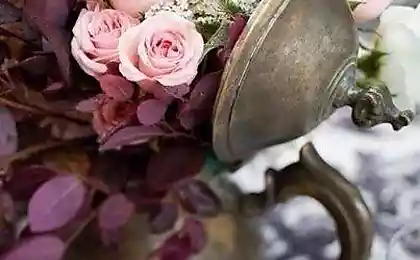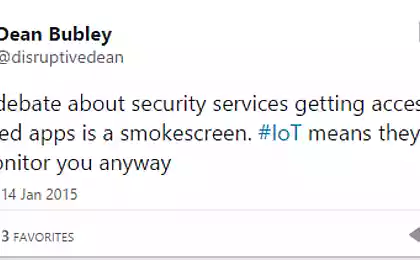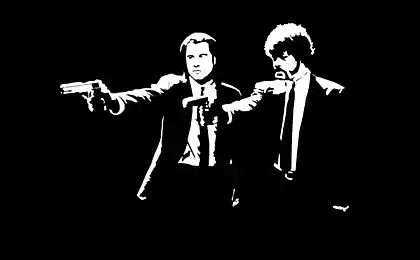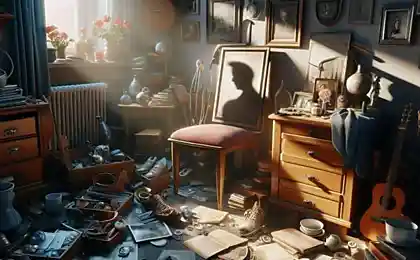1666
On the origin of things
For half of humanity. Safe britva.
can say that King Gillette Kemp, who was born in 1855 in the town of Fond du Lac County, Wisconsin, love to invent inherited. His father was a jack of all trades and worked as a patent attorney. King's mother was also an inventor - in the culinary field: her cookbook, first published in 1887, reprinted and still.
At age 17, King Gillette became a traveling salesman. However, he did not forget about Ingenuity: by 1890, in his "portfolio" was already 4 patents (although the benefits of them he did not have any). Looking at this, William Painter, inventor of the disposable bottle stoppers and founder of Crown Cork & Seal Co, he worked for King Gillette, gave him good advice. "If you want to make a profit by selling goods you invented inventing something disposable. Then, if the product will be the best, satisfied customers will be forced to turn to you again and again ».
Work associated with the traveling salesman constant traveling, and often had to shave Gillette trains. It was very risky because of the bumps on the rail joints straight razor could easily cut his throat. Gillette razor used the Star Safety Razor, made in the style of Chopper: the handle was attached perpendicularly to the massive blade. Razor quickly blunted, and it has to be part of the rules. In 1895, Gillette came up with a simple idea: to use instead of a massive blade thin steel strips that the loss of sharpness could be simply thrown away.
With this idea, he turned to metallurgy Massachusetts Institute of Technology (MIT), and they assured him that it is absolutely impossible. But Gillette did not give up and with engineer William Nickerson (ironically - a graduate of MIT) for six years developing design shaving razor blades and technology of their release. In 1901, Gillette and Nickerson founded the American Safety Razor Company, and two years later began mass production. Moreover, in order to create a market, first they even had to sell goods below cost.
In 1904, King Camp Gillette received a patent for his invention, and the company was renamed the Gillette Safety Razor Company. After this strong half of mankind learned inventor razor not only by name but also in person: each package with blades Gillette printed portrait of King Gillette (pictured above in the text).
To help the traveler - suitcases and bags with kolёsikami.
In 1970-1980-ies of the world covered thirst "to change places." But it was not easy for travelers - in the literal sense of the word: a hefty part of the journey had to drag luggage in hand or on yourself.
To their plight share one of the world's largest travel bags, the company Samsonite, in 1974, patented design of the suitcase with wheels located in one corner of the plastic housing. Pulling the handle on the other hand, such a case can be rolled in the inclined position. But the popularity of this particular case is not won (although it is produced to this day): on bends or irregularities, he collapses on his side and also did not fit on the upper shelves inside the aircraft. 46-year-old pilot of American Airlines Northwest Airlines Robert Plath fully experience for yourself heavy burden traveler.
He never considered himself an inventor and could not even assume that his decision to literally change the world. In 1988 in his garage in the town of Boca Raton, Florida Plat fastened to his beloved vertical bag two small wheels furniture bought in the nearest hardware store. To the side of the pocket sewn bags he masking retractable handle made of metal rods or tubes. Wide track two wheels provides stability rolling even when tight bends and overcomes obstacles rather large. Field (or flight) tests have confirmed all the best qualities of ideas fee. Pilots and flight attendants looked at an unusual design with undisguised surprise that some time later grew into envy. A few days later one of his colleagues turned to Robert with a request to upgrade his bag (of course, not free). Then another. When the number of orders exceeded ten, Plath began to give to colleagues, leads him to the following buyers, "commission" in the form of a discount of $ 5 on your next purchase. In 1989, Platt filed a patent application for "travel bag equipped with wheels and a retractable handle," he called Rollaboard. In the same year Plath founded Travelpro, and in 1991, when the patent number 4,995,487 was recorded, he resigned from the airline. Looking for pilots and flight attendants, easily rolling their bags down the aisles airports, passengers also began to wonder where you can buy a "miracle of technology." Demand was so high that even in the first year of its existence, the company has sold Travelpro bag for $ 1, 5 million.! And by 1999, when the board is retired and sold his stake in the company, sales were $ 50 million. The invention of Robert board changed the world of travel: few people today goes on a journey without traveling bag or suitcase on wheels. Travelpro products proved so popular that the airlines were forced to even increase the top shelves in airplanes. The only ones who lost their appearance, became porters - today with their hard work built an excellent job in a suitcase or bag wheels ...
Yanking the ring!
Bank with the valve and ring - the invention, to make life easier not only for lovers of beer.
Erma Cleon Frazee was born in 1913. Youth he spent on a farm in Indiana, and in 1940 moved to Dayton, Ohio, where earned his living by various mechanical and painting. In 1949 he founded a small company Frazee Reliable Tool and Manufacturing Co. ("Reliable tools and production"), where he was the only employee. Business was not very profitable, but life was missing. Frazee even patented a few small inventions, as well as finished technical school of General Motors and received a degree in engineering. By the end of 1950 among customers still small companies including such giants as General Electric, Ford, Chrysler and even NASA. One day in 1959 Erma Frazee, and for friends just Ernie decided to have a picnic with family and friends. When the snack was already sliced, and the food is ready, Ernie pulled from the trunk of one of the latest advances in technology of the time - beer, packaged in aluminum cans. There is a slight disappointment awaited him: it turned out that none of those present did not think to bring a can opener.
However, Ernie was not in vain skilled mechanic, he quickly came up with a way to open cans with the help of available tools and car bumper (although it turned more foam than beer). But he remembered this case - because such a trifle almost ruined a wonderful weekend. As a couple of months later, Frazee, suffering from insomnia, I decided to take the head of some everyday problems. Case with banks reminded itself. Later, the inventor said, "I did not come up with self-opening cans. I only suggested a way to attach the key to the lid of the jar. " Ernie was a simple solution - the key was attached to the center of the lid conventional rivets. The first option was not too successful - the key lever punched a hole in the bank with the sharp edges of which could cause injury. To solve this problem Frazee offered weaken part of the lid, making her preliminary non-through cuts. In 1963 he received a patent inventor and offered his company-manufacturer of cans Alcoa. The company took a chance and won - by 1965 more than 75% of all cans sold in the US, were provided with a key to open. In the 1970s, a system of opening cans has been improved - the key non-removable made as aluminum "tabs" with sharp edges heavily polluting. During this time the company Frazee, renamed the Dayton Reliable Tool, has become one of the leading suppliers of industrial equipment for the manufacture of cans, and by 1980 th annual income once small company has more than half a billion dollars.
Mockery cook. Potato chipsy.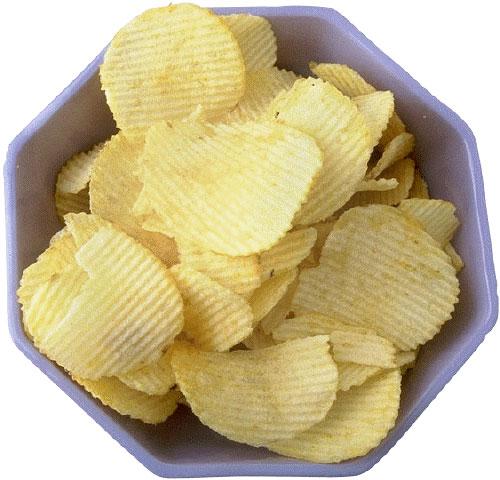
George Speck was born in 1822 in the town of Saratoga Lake, NY. His father was, as they say now, African American, and his mother - an Indian tribe of Huron. His real name George Crum chose the pseudonym under which his father served as a jockey. In his youth, George worked as a guide, a guide in the Adirondacks, but became older, he realized that his true calling - cooking. Summer 1853 he met at a resort in Saratoga Springs as a chef fashionable hotel Moon Lake Lodge. One of the specialties of the restaurant recipes was "fried potatoes in French." This dish came to America thanks to Thomas Jefferson, try fried potatoes while serving ambassador to France.
According to legend, one of the diners was unhappy with the dish - he said to the waiter that the potatoes are sliced too thick slices and therefore not enough to fry. Angered by Crum decided to stand up for his sister, who worked as his assistant and, in fact, and sliced potatoes. Having decided to make fun of the visitor, he cut potatoes into layers literally paper-thin, and then fry them in oil. To the surprise of the boss, demanding visitor was satisfied, and the other guests began to order "Saratoga Chips" (a name given to the new recipe), which soon became the most popular specialty restaurant.
In 1860, Crum opened his own restaurant - Crumbs House (he worked until 1890), on each table which was a basket of chips. The restaurant quickly became a fashionable place among the visitors to the resorts wealthiest Americans. Krum did not sell chips "takeaway", but the recipe was so simple that a dish quickly spread around the country and has become a mandatory attribute of self-respecting restaurants.
Buy chips at the store became possible only in 1895, when William Teppendon began their "limited production" (first in your own kitchen, and later on they built a factory) and began delivering them to grocers Cleveland, where the chips are sold packaged weighted. The final touch to the "construction" of chips made Laura Scudder. It is proposed to use as packaging waxed paper - so was born the concept of "bag of chips." In 1932, Herman Lay established in Nashville, Tennessee, brand Lay's, which was the first national brand of chips, dozhivshim to the present day.
Today every Russian consumes an average of 0, 5 kg of chips per year, European - 1-5 kg, American - 10 kg.
Paperclip. Unite, the sheets and the nation!
The clip - one of the most versatile productivity tools. It is used for dozens of different applications: as a screwdriver, poker chip, a toothpick or lockpick ...
In the XIII century the original "folders" to fasten sheets: in the upper left corner of the incision is made, and is passed through them, cloth tape. The first step in a massive steel sewing pins, invented in 1835 by American physician John Howie. New York secretary quickly discovered that the pins can attach up to ten sheets. Pins resisted: stabbed and left on paper unsightly holes. In 1890 the offices began to use wire springs (proposed in 1867 by Samuel Fay for a completely different purpose - securing clothing labels). In 1899, the Norwegian Johan Vaaler engineer, experimenting with pieces of spring wire, came up with some good designs staples and received a patent for his invention. Vaaler but did not pay attention to this project, and in 1900 the American inventor Cornelius Brosnan patented clip, named Konaclip. However, modern look, this stationery acquired through the efforts of the British company Gem Manufacturing, which issued in the same year as the Gem clip classical double oval. It's only in the United States each year sold about 20 billion. Staples, though, according to some studies, no more than 5% of them are used for their intended purpose.
The clip has become an indispensable accessory in any office. But for the people of Norway, this little piece of wire is also a deep symbolic significance. This is due to the heroic story that happened during World War II. In 1940, invading a country, the Nazis put in power occupation government and banned local residents to wear buttons and icons with the initials of the exiled Norwegian King Haakon VII. Then Norwegians remembered most famous national invention and began to wear on clothing staples that have become a true symbol of national unity and resistance (for it could easily end up in jail). Feat and merits of the inventor has not been forgotten: the Oslo Johan Vaaler is a monument in the form of a giant paper clip.
Scotch, but the Scot and viski
The English word «scotch», first of all, means "the Scots", "Scottish". More so called whiskey. When we say "Scotch", they usually mean Gluing (adhesive, sticky) tape.
To begin with, that has not been invented Scotch or Scotch plaid, and even this does not happen in Scotland. Adhesive tape was invented in America, and that's how it was.
In 1923, a young man named Richard Drew (Richard G. Drew), a banjo player (this fact somehow needs to be specified), got a job in a company, modestly been making sandpaper.
The company Minnesota Mining and Manufacturing (now the name of this major corporation decreased to 3M) was prepared for him the post of laboratory technician. Actually, with sandpaper and he had to work. True, the research division of 3M are trying to master new activities and develop waterproof coating, experimenting with cellophane.
Banjo player, these wrappers were interesting, but at the moment his employer tested the shops and garages his new skins «Wetordry», and Drew was entrusted to oversee this process.
Once, while in the garage, Richard noticed that the master engaged in painting car bodies, have difficulty: where the surface had to paint two or more colors, the dividing line is that sloppy. Although to protect one painted plane and used paper called Kraft Paper, with the removal of these papers are separated with paint. In general - it was uncomfortable.
And Drew painter promised to think of something. After some time - in 1925, whether that year - Richard really brought this to the employee the tape width of 2 inches (5 cm) with a plaster on each edge.
"Avtozhivopisets" decided to use the prototype in the case, but when going to apply a different color, noticed that the tape Drew skukozhilas. Only then carefully studied the master tape and realized that she had just glued around the edges and in the middle - not (now say that Richard did not sample is completely tacky for reasons of economy).
And as in the days of the Scottish thrift - or rather, avarice, legends, the disgruntled painter in the hearts cried out, "Take this tape, send your Scotch bosses and tell them to make it more sticky!»
It is clear that no «Scotch bosses» Drew was not, but a word to the tape as if stuck, and the inventor of continued experiments.
During Richard improvements had to solve many problems, such as uniform distribution of the adhesive mass on the tape surface and so on. On completion took about 5 years and 8 September 1930 the first roll of "Scotch" cellophane tape was sent to a sample client in Chicago.
The answer came to him from encouraging: "You can be sure not to save, releasing this product to the market. Sales will justify all costs ».
The world's first tape was made of rubber, resins and oils based on cellophane. He was waterproof and withstand a wide range of temperatures.
Hanger-plechiki.
Such a natural and familiar in today's everyday life a thing as a hanger, it turns out was invented relatively recently - only in 1903.
Prior to this event znametalnogo people hang clothes on hooks. But, it is not surprising patent hook for clothes was received by some OA By North only in 1869!
At that before people hung their things - is not clear.
It was only in 1903, Albert Parkhouse, who worked on the wire factory, in response to the constant complaints of workers that they do not have hooks for their coats, invented hanger.
Wire he made two ovals that are opposite each other at a distance, and their ends are connected to the hook. In 1932, these ovals joined cardboard to wet clothes do not sag and myalas.
And three years later, was invented hanger with the bottom bracket, which became the prototype for all modern hangers.
Source

can say that King Gillette Kemp, who was born in 1855 in the town of Fond du Lac County, Wisconsin, love to invent inherited. His father was a jack of all trades and worked as a patent attorney. King's mother was also an inventor - in the culinary field: her cookbook, first published in 1887, reprinted and still.
At age 17, King Gillette became a traveling salesman. However, he did not forget about Ingenuity: by 1890, in his "portfolio" was already 4 patents (although the benefits of them he did not have any). Looking at this, William Painter, inventor of the disposable bottle stoppers and founder of Crown Cork & Seal Co, he worked for King Gillette, gave him good advice. "If you want to make a profit by selling goods you invented inventing something disposable. Then, if the product will be the best, satisfied customers will be forced to turn to you again and again ».
Work associated with the traveling salesman constant traveling, and often had to shave Gillette trains. It was very risky because of the bumps on the rail joints straight razor could easily cut his throat. Gillette razor used the Star Safety Razor, made in the style of Chopper: the handle was attached perpendicularly to the massive blade. Razor quickly blunted, and it has to be part of the rules. In 1895, Gillette came up with a simple idea: to use instead of a massive blade thin steel strips that the loss of sharpness could be simply thrown away.
With this idea, he turned to metallurgy Massachusetts Institute of Technology (MIT), and they assured him that it is absolutely impossible. But Gillette did not give up and with engineer William Nickerson (ironically - a graduate of MIT) for six years developing design shaving razor blades and technology of their release. In 1901, Gillette and Nickerson founded the American Safety Razor Company, and two years later began mass production. Moreover, in order to create a market, first they even had to sell goods below cost.
In 1904, King Camp Gillette received a patent for his invention, and the company was renamed the Gillette Safety Razor Company. After this strong half of mankind learned inventor razor not only by name but also in person: each package with blades Gillette printed portrait of King Gillette (pictured above in the text).
To help the traveler - suitcases and bags with kolёsikami.

In 1970-1980-ies of the world covered thirst "to change places." But it was not easy for travelers - in the literal sense of the word: a hefty part of the journey had to drag luggage in hand or on yourself.
To their plight share one of the world's largest travel bags, the company Samsonite, in 1974, patented design of the suitcase with wheels located in one corner of the plastic housing. Pulling the handle on the other hand, such a case can be rolled in the inclined position. But the popularity of this particular case is not won (although it is produced to this day): on bends or irregularities, he collapses on his side and also did not fit on the upper shelves inside the aircraft. 46-year-old pilot of American Airlines Northwest Airlines Robert Plath fully experience for yourself heavy burden traveler.
He never considered himself an inventor and could not even assume that his decision to literally change the world. In 1988 in his garage in the town of Boca Raton, Florida Plat fastened to his beloved vertical bag two small wheels furniture bought in the nearest hardware store. To the side of the pocket sewn bags he masking retractable handle made of metal rods or tubes. Wide track two wheels provides stability rolling even when tight bends and overcomes obstacles rather large. Field (or flight) tests have confirmed all the best qualities of ideas fee. Pilots and flight attendants looked at an unusual design with undisguised surprise that some time later grew into envy. A few days later one of his colleagues turned to Robert with a request to upgrade his bag (of course, not free). Then another. When the number of orders exceeded ten, Plath began to give to colleagues, leads him to the following buyers, "commission" in the form of a discount of $ 5 on your next purchase. In 1989, Platt filed a patent application for "travel bag equipped with wheels and a retractable handle," he called Rollaboard. In the same year Plath founded Travelpro, and in 1991, when the patent number 4,995,487 was recorded, he resigned from the airline. Looking for pilots and flight attendants, easily rolling their bags down the aisles airports, passengers also began to wonder where you can buy a "miracle of technology." Demand was so high that even in the first year of its existence, the company has sold Travelpro bag for $ 1, 5 million.! And by 1999, when the board is retired and sold his stake in the company, sales were $ 50 million. The invention of Robert board changed the world of travel: few people today goes on a journey without traveling bag or suitcase on wheels. Travelpro products proved so popular that the airlines were forced to even increase the top shelves in airplanes. The only ones who lost their appearance, became porters - today with their hard work built an excellent job in a suitcase or bag wheels ...
Yanking the ring!

Bank with the valve and ring - the invention, to make life easier not only for lovers of beer.
Erma Cleon Frazee was born in 1913. Youth he spent on a farm in Indiana, and in 1940 moved to Dayton, Ohio, where earned his living by various mechanical and painting. In 1949 he founded a small company Frazee Reliable Tool and Manufacturing Co. ("Reliable tools and production"), where he was the only employee. Business was not very profitable, but life was missing. Frazee even patented a few small inventions, as well as finished technical school of General Motors and received a degree in engineering. By the end of 1950 among customers still small companies including such giants as General Electric, Ford, Chrysler and even NASA. One day in 1959 Erma Frazee, and for friends just Ernie decided to have a picnic with family and friends. When the snack was already sliced, and the food is ready, Ernie pulled from the trunk of one of the latest advances in technology of the time - beer, packaged in aluminum cans. There is a slight disappointment awaited him: it turned out that none of those present did not think to bring a can opener.
However, Ernie was not in vain skilled mechanic, he quickly came up with a way to open cans with the help of available tools and car bumper (although it turned more foam than beer). But he remembered this case - because such a trifle almost ruined a wonderful weekend. As a couple of months later, Frazee, suffering from insomnia, I decided to take the head of some everyday problems. Case with banks reminded itself. Later, the inventor said, "I did not come up with self-opening cans. I only suggested a way to attach the key to the lid of the jar. " Ernie was a simple solution - the key was attached to the center of the lid conventional rivets. The first option was not too successful - the key lever punched a hole in the bank with the sharp edges of which could cause injury. To solve this problem Frazee offered weaken part of the lid, making her preliminary non-through cuts. In 1963 he received a patent inventor and offered his company-manufacturer of cans Alcoa. The company took a chance and won - by 1965 more than 75% of all cans sold in the US, were provided with a key to open. In the 1970s, a system of opening cans has been improved - the key non-removable made as aluminum "tabs" with sharp edges heavily polluting. During this time the company Frazee, renamed the Dayton Reliable Tool, has become one of the leading suppliers of industrial equipment for the manufacture of cans, and by 1980 th annual income once small company has more than half a billion dollars.
Mockery cook. Potato chipsy.

George Speck was born in 1822 in the town of Saratoga Lake, NY. His father was, as they say now, African American, and his mother - an Indian tribe of Huron. His real name George Crum chose the pseudonym under which his father served as a jockey. In his youth, George worked as a guide, a guide in the Adirondacks, but became older, he realized that his true calling - cooking. Summer 1853 he met at a resort in Saratoga Springs as a chef fashionable hotel Moon Lake Lodge. One of the specialties of the restaurant recipes was "fried potatoes in French." This dish came to America thanks to Thomas Jefferson, try fried potatoes while serving ambassador to France.
According to legend, one of the diners was unhappy with the dish - he said to the waiter that the potatoes are sliced too thick slices and therefore not enough to fry. Angered by Crum decided to stand up for his sister, who worked as his assistant and, in fact, and sliced potatoes. Having decided to make fun of the visitor, he cut potatoes into layers literally paper-thin, and then fry them in oil. To the surprise of the boss, demanding visitor was satisfied, and the other guests began to order "Saratoga Chips" (a name given to the new recipe), which soon became the most popular specialty restaurant.
In 1860, Crum opened his own restaurant - Crumbs House (he worked until 1890), on each table which was a basket of chips. The restaurant quickly became a fashionable place among the visitors to the resorts wealthiest Americans. Krum did not sell chips "takeaway", but the recipe was so simple that a dish quickly spread around the country and has become a mandatory attribute of self-respecting restaurants.
Buy chips at the store became possible only in 1895, when William Teppendon began their "limited production" (first in your own kitchen, and later on they built a factory) and began delivering them to grocers Cleveland, where the chips are sold packaged weighted. The final touch to the "construction" of chips made Laura Scudder. It is proposed to use as packaging waxed paper - so was born the concept of "bag of chips." In 1932, Herman Lay established in Nashville, Tennessee, brand Lay's, which was the first national brand of chips, dozhivshim to the present day.
Today every Russian consumes an average of 0, 5 kg of chips per year, European - 1-5 kg, American - 10 kg.
Paperclip. Unite, the sheets and the nation!

The clip - one of the most versatile productivity tools. It is used for dozens of different applications: as a screwdriver, poker chip, a toothpick or lockpick ...
In the XIII century the original "folders" to fasten sheets: in the upper left corner of the incision is made, and is passed through them, cloth tape. The first step in a massive steel sewing pins, invented in 1835 by American physician John Howie. New York secretary quickly discovered that the pins can attach up to ten sheets. Pins resisted: stabbed and left on paper unsightly holes. In 1890 the offices began to use wire springs (proposed in 1867 by Samuel Fay for a completely different purpose - securing clothing labels). In 1899, the Norwegian Johan Vaaler engineer, experimenting with pieces of spring wire, came up with some good designs staples and received a patent for his invention. Vaaler but did not pay attention to this project, and in 1900 the American inventor Cornelius Brosnan patented clip, named Konaclip. However, modern look, this stationery acquired through the efforts of the British company Gem Manufacturing, which issued in the same year as the Gem clip classical double oval. It's only in the United States each year sold about 20 billion. Staples, though, according to some studies, no more than 5% of them are used for their intended purpose.
The clip has become an indispensable accessory in any office. But for the people of Norway, this little piece of wire is also a deep symbolic significance. This is due to the heroic story that happened during World War II. In 1940, invading a country, the Nazis put in power occupation government and banned local residents to wear buttons and icons with the initials of the exiled Norwegian King Haakon VII. Then Norwegians remembered most famous national invention and began to wear on clothing staples that have become a true symbol of national unity and resistance (for it could easily end up in jail). Feat and merits of the inventor has not been forgotten: the Oslo Johan Vaaler is a monument in the form of a giant paper clip.
Scotch, but the Scot and viski

The English word «scotch», first of all, means "the Scots", "Scottish". More so called whiskey. When we say "Scotch", they usually mean Gluing (adhesive, sticky) tape.
To begin with, that has not been invented Scotch or Scotch plaid, and even this does not happen in Scotland. Adhesive tape was invented in America, and that's how it was.
In 1923, a young man named Richard Drew (Richard G. Drew), a banjo player (this fact somehow needs to be specified), got a job in a company, modestly been making sandpaper.
The company Minnesota Mining and Manufacturing (now the name of this major corporation decreased to 3M) was prepared for him the post of laboratory technician. Actually, with sandpaper and he had to work. True, the research division of 3M are trying to master new activities and develop waterproof coating, experimenting with cellophane.
Banjo player, these wrappers were interesting, but at the moment his employer tested the shops and garages his new skins «Wetordry», and Drew was entrusted to oversee this process.
Once, while in the garage, Richard noticed that the master engaged in painting car bodies, have difficulty: where the surface had to paint two or more colors, the dividing line is that sloppy. Although to protect one painted plane and used paper called Kraft Paper, with the removal of these papers are separated with paint. In general - it was uncomfortable.
And Drew painter promised to think of something. After some time - in 1925, whether that year - Richard really brought this to the employee the tape width of 2 inches (5 cm) with a plaster on each edge.
"Avtozhivopisets" decided to use the prototype in the case, but when going to apply a different color, noticed that the tape Drew skukozhilas. Only then carefully studied the master tape and realized that she had just glued around the edges and in the middle - not (now say that Richard did not sample is completely tacky for reasons of economy).
And as in the days of the Scottish thrift - or rather, avarice, legends, the disgruntled painter in the hearts cried out, "Take this tape, send your Scotch bosses and tell them to make it more sticky!»
It is clear that no «Scotch bosses» Drew was not, but a word to the tape as if stuck, and the inventor of continued experiments.
During Richard improvements had to solve many problems, such as uniform distribution of the adhesive mass on the tape surface and so on. On completion took about 5 years and 8 September 1930 the first roll of "Scotch" cellophane tape was sent to a sample client in Chicago.
The answer came to him from encouraging: "You can be sure not to save, releasing this product to the market. Sales will justify all costs ».
The world's first tape was made of rubber, resins and oils based on cellophane. He was waterproof and withstand a wide range of temperatures.
Hanger-plechiki.

Such a natural and familiar in today's everyday life a thing as a hanger, it turns out was invented relatively recently - only in 1903.
Prior to this event znametalnogo people hang clothes on hooks. But, it is not surprising patent hook for clothes was received by some OA By North only in 1869!
At that before people hung their things - is not clear.
It was only in 1903, Albert Parkhouse, who worked on the wire factory, in response to the constant complaints of workers that they do not have hooks for their coats, invented hanger.
Wire he made two ovals that are opposite each other at a distance, and their ends are connected to the hook. In 1932, these ovals joined cardboard to wet clothes do not sag and myalas.
And three years later, was invented hanger with the bottom bracket, which became the prototype for all modern hangers.
Source

